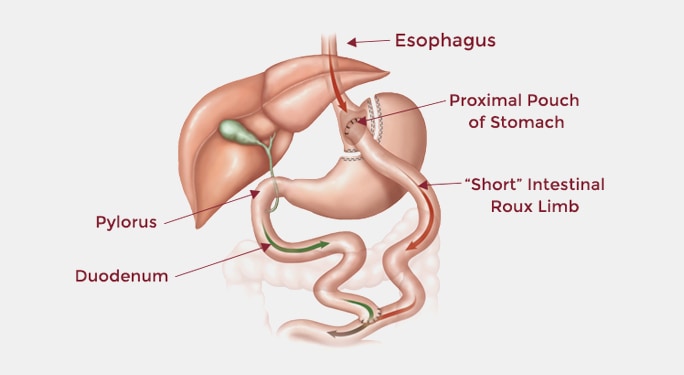GASTRIC BYPASS IS ONE OF THE MOST COMMON SURGICAL PROCEDURES USED IN THE TREATMENT OF OBESITY AROUND THE WORLD.
Gastric Bypass surgery is a restrictive/malabsorptive surgical procedure. It is restrictive in the sense that it “restricts” how much food the stomach can hold and is “malabsorptive” in that it affects how food and calories are absorbed into the bloodstream. This combination surgery has the highest success rate for amount of weight lost.
The two most common types of gastric bypass surgery are the Roux-en-Y, and the Single Anastomosis (Omega-loop) gastric bypass . Both of these types of gastric bypass surgery are done laparoscopically (keyhole surgery), using 4-5 small incisions. Your surgeon will help you decide which option is best for you, but generally the Omega-loop gastric bypass is preferred unless you have severe reflux.
In both types of gastric bypass surgery, the surgeon creates a small stomach pouch by dividing the stomach into two using surgical staplers along the upper part of the stomach. A new opening from this pouch is then created, and joined to the small intestine to allow food to exit the pouch.
This prevents food entering the stomach and some of the small intestine (the duodenum and part of the jejunum), and achieves significant calorie restriction as well as some malabsorption. It also causes very beneficial alterations to the hormones made by the gut, as well as making the composition of gut bacteria more healthy (the gut microbiota). Because of these effects the Gastric Bypass is highly effective at treating diabetes, which can be completely reversed in many cases.
ADVANTAGES OF GASTRIC BYPASS SURGERY INCLUDE:
-
Quick weight loss- most patients lose their weight within 12 months
-
Good long term weight control- studies show continued weight control beyond 15 years post-surgery
-
Patients lose between 60-70% of their excess weight on average
-
Improved health problems associated with severe obesity, especially Diabetes
-
Improved mobility and quality of life

